
Get a first impression, scheduled soon.
Request a demo to see how NIPO can help you meet your requirements with our smart survey solutions.
A series of Nfield CAPI Academy sessions, covering essentials from basic CAPI setup to more advanced sampling methods. Part V.
Session content:
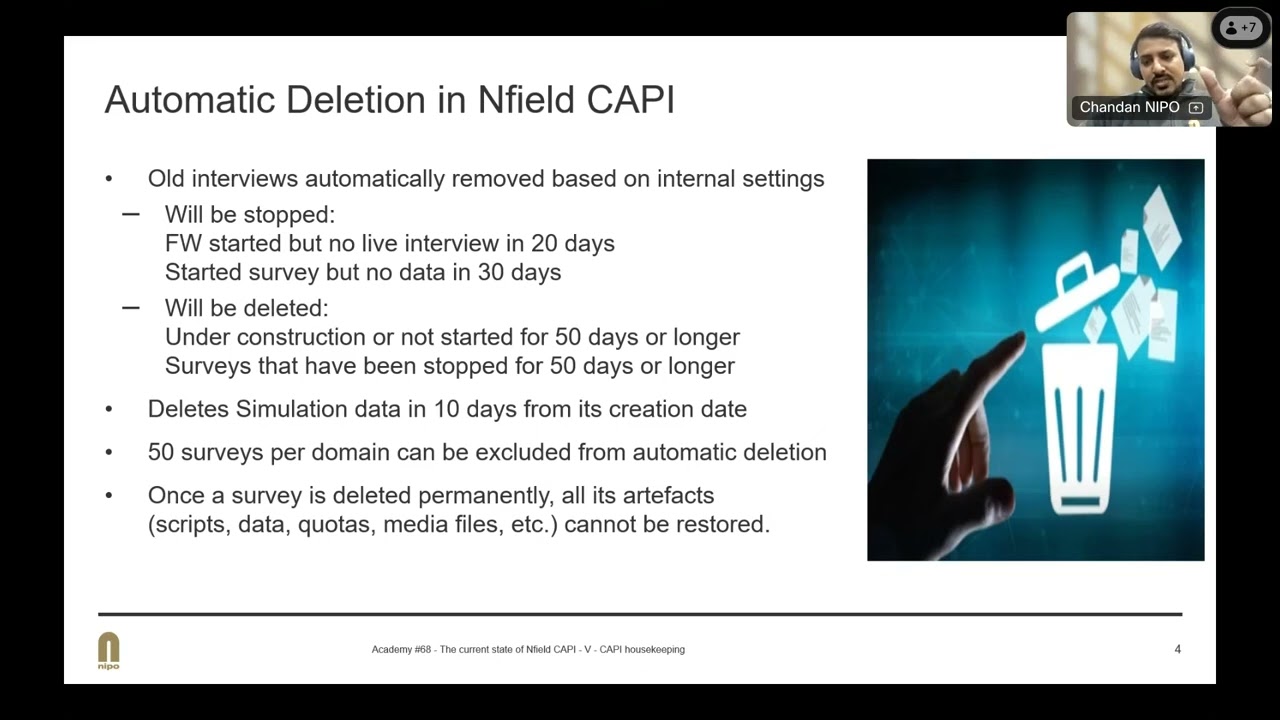
A series of Nfield CAPI Academy sessions, covering essentials from basic CAPI setup to more advanced sampling methods. Part IV.
Session content:
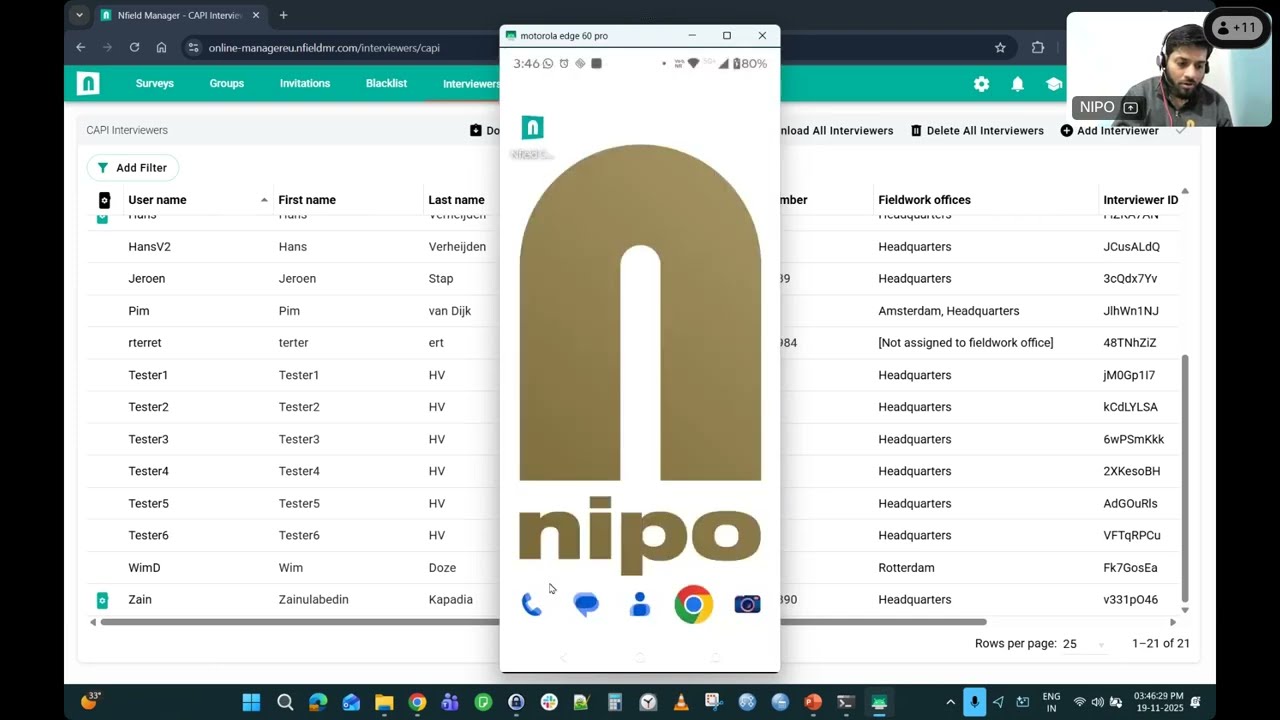
A series of Nfield CAPI Academy sessions, covering essentials from basic CAPI setup to more advanced sampling methods. Part III.
Session content:
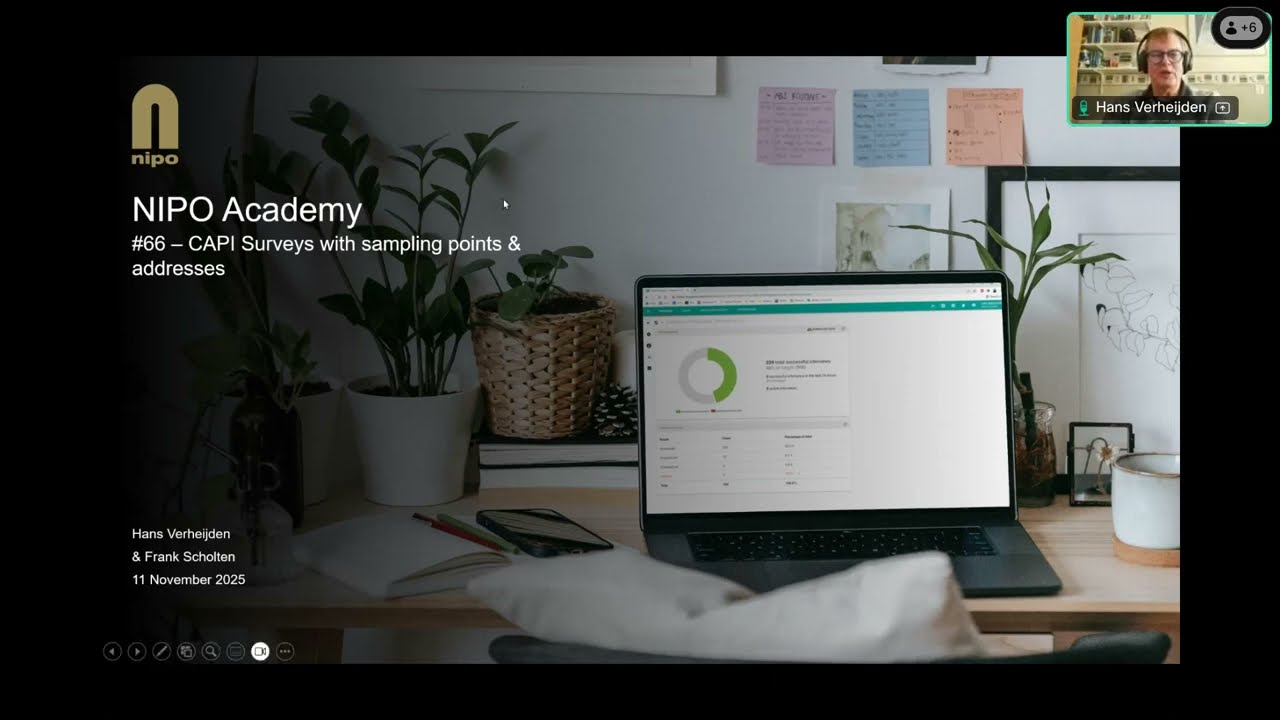
A series of Nfield CAPI Academy sessions, covering essentials from basic CAPI setup to more advanced sampling methods. Part II.
Session content:
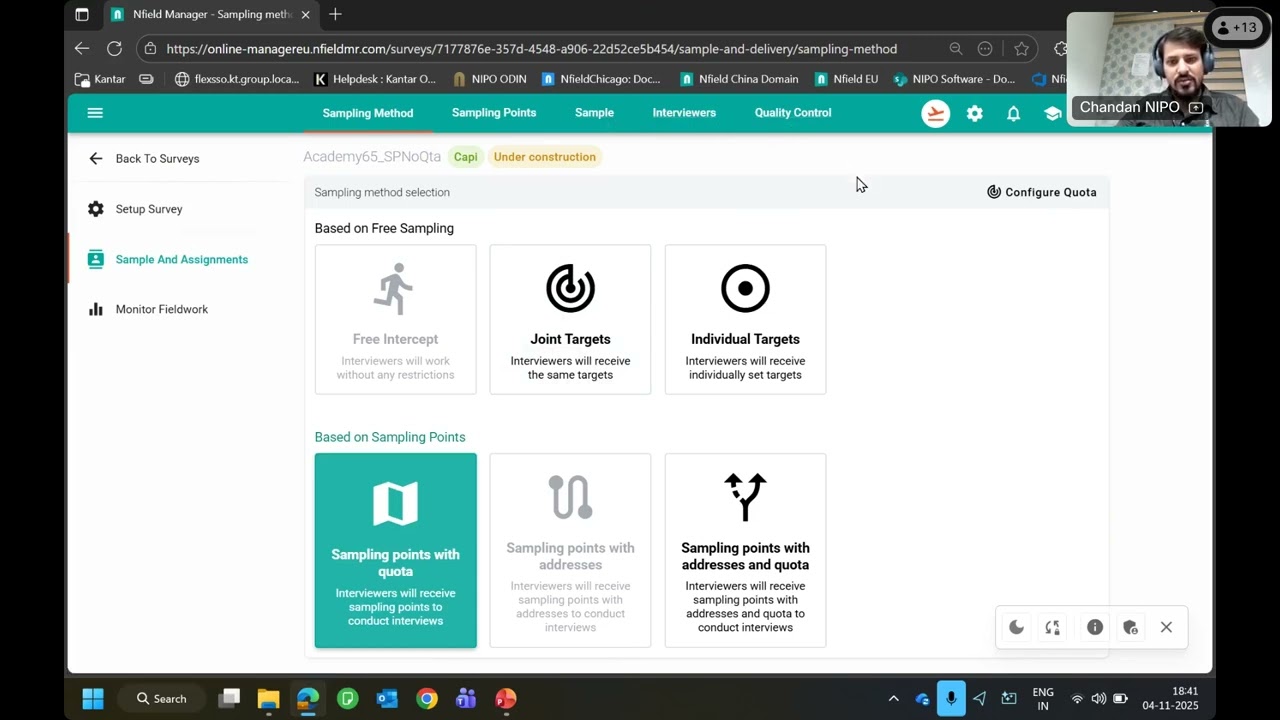
A series of Nfield CAPI Academy sessions, covering essentials from basic CAPI setup to more advanced sampling methods. Part I.
Session content:
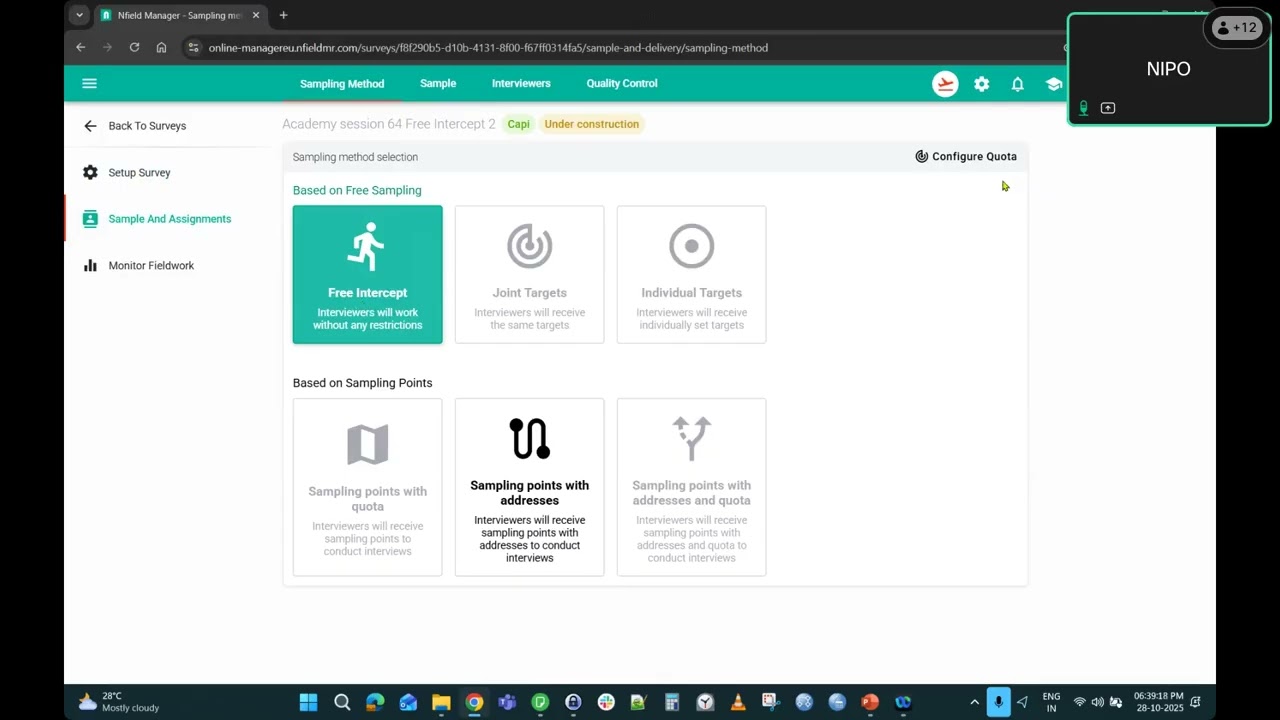
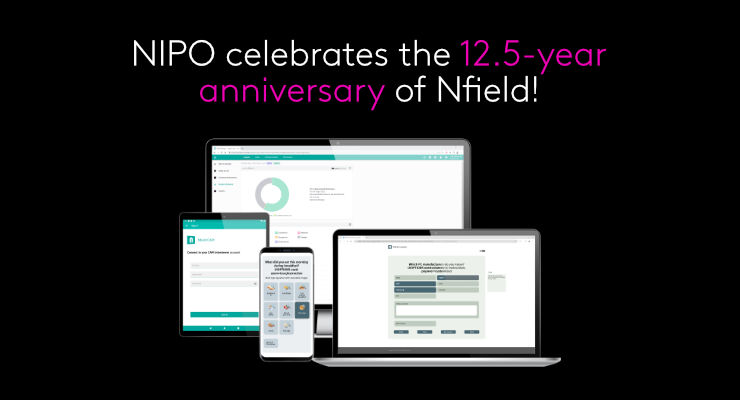
Over the past few months, NIPO has introduced powerful new enhancements to the ODIN scripting language, designed to make your survey creation faster, smarter, and more flexible. In these NIPO Academy sessions, we’ll walk you through all the latest additions.
These features include:
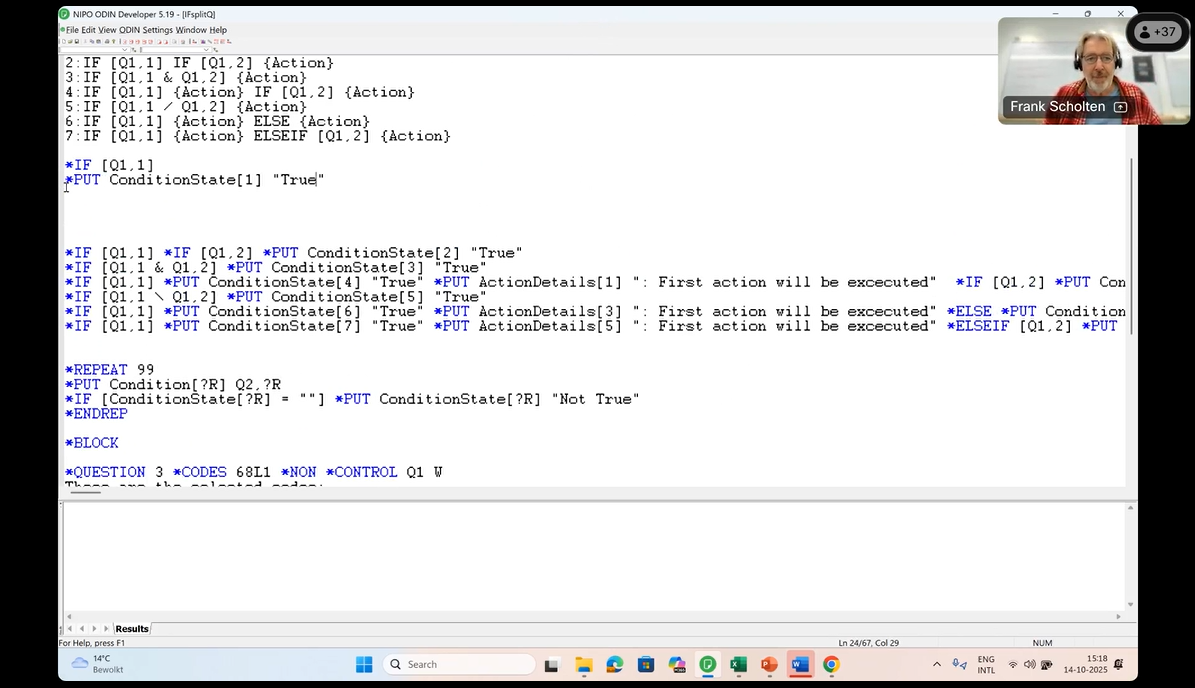
Nfield CAPI is designed to run on Android tablets and phones. With so many different Android devices to choose from it is good to understand the considerations that are of importance when making the decision to go for one device or the other.
And with so many differences in usage, there is no device that is best for everyone. Which device is best suited for you depends completely on the kind of surveys that you run, the environment in which your interviewers work, how you want to depreciate your devices and many more factors. This document tries to help you identify some of the choices you will need to make when selecting a device to support your face2face interviewing business.
Nfield CAPI cannot run on any Android device. Some devices are so cheap, that they just do not have enough processing or memory power to run Nfield interviews. Also manufacturers sometimes experiment with the specs of their machines with the result that they run Android but not all the apps from the app store.
Make sure that you test the devices that you intend to use for fieldwork before you buy them. Ask your supplier for a test machine, download the Nfield CAPI app and perform a test interview. If this works, and the speed is to your liking, order the devices; if not, then you know that this device is not for you.
To use the latest Nfield app and templates, NIPO recommends that you use Android devices with these specs:
| Minimum specs when using existing hardware: | Recommended specs when buying new devices: | |
| Android version: | 13 | 16 (or 15 with the option to later upgrade to 16) |
| Processor: | Quad core | Octa core |
| Memory: | 2GB RAM | 4GB RAM |
| Storage: | 32GB | 64GB |
Although you can use Nfield CAPI on both tablets and smart phones, the types of surveys that you want to run on Nfield might drive the choice for a typical device. If your surveys are very media heavy because you use a lot of show cards or video, you will probably consider 10” tablets to be the most suited device. If you are mainly doing quick exit polls a 4” or 5” smart phone might be your device of choice. Whichever device you choose, think carefully about all the types of surveys that you would like to run on these devices and not just about the project at hand. This prevents that you buy devices only for this one project that you then cannot use for other projects.
It makes a big difference whether you are conducting interviews on-the-street or in-the-home. On-the-street you might have to deal with unpredictable weather conditions or direct sunlight, whereas in-the-home interviews tend to be much longer in length and hence the device ergonomics become more important. We advise that you take these things into consideration when buying your device. You are strongly recommended to thoroughly test if the device is suitable for your interviewers before bulk purchasing devices for your fieldwork department(s).
On-the-street interviewing
When working outside you will need to factor in weather conditions. Especially direct sunlight can render tablets useless because of screen glare or a screen backlight that is just not powerful enough. You can use protective screen stickers that reduce glare but against poor backlight not much can be done. When you expect your interviewers to work in wet or dusty conditions make sure you select devices that are water proof. Many manufacturers nowadays have models in which the openings are covered to prevent water or dust damage.
Extended holding of the device
When your interviewers need to hold the device in their hands for an extended period of time, you might consider buying ergonomic sleeves for the tablets that protect the tablet and make it easy for the interviewer to hold and carry. If your interviewers are working much in the home of the respondent you might want to consider a sleeve that can be used as a standard or even one that comes with an integrated keyboard for easier typing.
Working in unsafe situations
Tablets and smart phones are objects of desire. Not everyone is able to afford these devices so they are prone to theft. If you know that your interviewer is going to work in a potentially unsafe situation make sure they can hide the tablet when walking on the street or choose a deliberately less appealing device. Make sure your interviewer does not become an unnecessary victim.
The Nfield CAPI app can sync with the Nfield server using mobile network or wifi. It is up to you to decide if you want to carry the extra cost involved with mobile connectivity. When deciding this you should take into consideration how easy your interviewers can access wifi, how quick you want access to the survey outcome, how often you need them to sync quotas etcetera.
When choosing a device you have the choice between wifi enabled devices or 5G enabled devices. The first only supports wifi, the latter both wifi and mobile networks. This does not mean that you need a mobile data subscription with a 5G enabled device; it only means that you can use such a subscription with that device. If you are not sure yet about using 5G we advise that you first buy a limited set of mobile network enabled devices and decide based on your experience in field about which type of connectivity you really need. Although 5G enabled devices are more expensive, in this way you won’t end up with a set of wifi only devices when you find that you do need mobile data connectivity.
Is it worth investing in a smart-pen or not? The answer is not the same for everyone. For most research you won’t need a smart-pen; your interviewers click only on buttons. Fingers are perfectly suited to that task. However, if you are based in China, Japan or any other country where they use a more elaborate character type set, a pen might prove valuable as keyboard input will be drawn on the keypad rather than typed.
Also, if you require interviewers or respondent to create detailed drawings or require them to sign off on their work a smart-pen might prove a valuable addition. In all other cases a smart-pen is probably an extra that you won’t need. If you do supply your interviewers with a smart-pen, make sure it is physically attached to the tablet or the tablet’s sleeve, as a pen is easily lost and often expensive to replace.
One of the things you really do not want is that your interviewer is working in field and the battery suddenly dies. Make sure the tablet you are using has at least a factory stated battery life that is 125% of what you would need in field. So if your interviewers on average work 6 hours per day, make sure the stated battery life is at least 7.5 hours. Be aware that the stated maximum battery life is valid for use with minimum backlight. Unfortunately most tablets do not allow you to replace the battery. As almost all batteries degrade over time, you might consider equipping interviewers with a mobile power supply that functions as a portable battery.
With the average tablet costing between $250 and $650 it is a worthwhile question to ask yourself how long you expect a tablet to last in field. With PC’s many market research companies use a 3 to 4 year depreciation scheme. For tablets and smart phones you might consider reducing this to 2 years. Not only because tablets are cheaper, but also because the specs are changing so quickly a 2 year old tablet might look outdated after this period.
Especially when you consider buying a device that is not running on the latest Android OS, do take into account that life span will be shorter.
If looking outdated is not a problem, you might go the other direction and look for a durable device that will last 4 years or even more. In that case consider the more expensive ruggedized type of tablets and smart phones that are used at construction sites. These devices are shock proof, water proof, dust proof, can be used in direct sunlight and come with replaceable batteries. But they also come with a much higher price tag that can easily exceed $1,000.
A question you need to ask yourself is whether you want to insure your devices. Annual insurance costs are often around 20% of the value of the device. This means that on a company level you will need to claim 20% of the machines in a given year as damaged/broken/lost to break-even. When you have only a limited number of devices it is often a smart idea to have insurance as 1 or 2 broken devices can have a big impact on the total cost of ownership, but for a larger field force it is often cheaper to repair or replace broken devices at your own expense than to have the devices insured.
Many manufacturers offer a standard one-year warranty on their products. In many cases it is possible to buy an additional one-year warranty. Before you consider this offer, check your local legislation on warranty as several countries require manufacturers to give a two-year warranty by law. If you do not have two-year warranty by law, the arguments for deciding about extended warranty are the same as for insurance.
Have you thought about how you will secure and manage the devices? You probably do not want your interviewers using the tablet for other purposes than interviewing. And when the device gets lost or stolen you will want the ability to retrieve it, lock it down or even remote wipe content from it. There are some really good out of the box solutions that you can use to manage these things for you. Which solutions suits you best depends on your needs and on the amount of money you are willing to spend on a solution.
Often the device manufacturer itself has a free built in service that allows you to register devices and trace it or wipe it remotely in case of loss. These services assume you are the owner of the device so they include no features for content or usage management. If you want these features you will be looking for Mobile Device Management (MDM) solutions that allow you to control what users can do on a device and even completely manage your devices remotely. These extra features do come at a cost though; how much depends on what solution you choose, but expect to pay around $20 per device annually for an MDM solution.
Some MDM solutions allow you to whitelist websites that may be visited with the device. Although a very handy feature, it may also cause problems when using public wifi. If you allow your interviewers to use public wifi networks, make sure that you have whitelisted the login pages of the WiFi networks they are most likely to use. Otherwise they won’t be able to connect to the Internet if the wifi network requires a username and/or password.
Google releases regular updates of its Android operating system. Many manufacturers distribute these updates to devices sold in the years before. During the lifecycle of a fieldwork device you can expect to receive one or more updates of the device’s software version. We advise that you only update your devices to a newer Android version after having thoroughly tested it on at least one device.
When you are using Google’s own tablets it is especially important that your test extensively before you update them as Google often pushes out breaking changes without prior notification. Other hardware suppliers typically update two to three months after the new Android version is launched, giving NIPO enough time to adapt the Nfield CAPI app to any breaking changes a new Android version might introduce.
However, because each tablet model has its own Android ‘version’, it is impossible for NIPO to test all devices and Android updates that become available. It is not possible to have the device automatically update the Android version. It needs a manual action from the device user or you can push it using MDM software. When an update for the Android version becomes available for your fieldwork devices the person working with this device will be notified of the update. If you want to prevent them from installing the Android update, make sure your devices are managed using MDM software.
Over the years we have developed and supported numerous Nfield CAPI apps. As you can imagine we cannot support all versions indefinitely. With this new strategy we limit the number of Nfield CAPI app versions out in the field.
This will not only save time we spend on investigating problems on older versions of the Nfield CAPI app, but we will use that time to add new features and strengthen the current options that are available. This will also encourage our customers to upgrade to the latest version of the Nfield CAPI app and start using the new features we are continuously developing.
We will update the minimum supported version every quarter. So please keep an eye out on the communications we share about this subject. All our communications can also be found in the release notes section in the ‘Knowledge centre’ in Nfield Manager. If you are still using the classic Nfield Manager, communication can be found in the customer section of our website.
Minimum supported Nfield CAPI app
As of 1 September 2025, the minimum version for the Nfield CAPI app will be 2.32.
Interviewing devices that are running a version of the app that is lower will no longer be able to synchronize. As a domain administrator it is important to act and share this news within your organization, so it gets to the attention of the people that should take action.
If you are working with older Nfield CAPI apps that will stop being supported, now is the time to ensure business continuity by keeping CAPI devices updated with the required minimum app versions.
Supported Android versions
We align our development efforts with the support Google gives on their versions of the Android mobile operating system. The new versions of the Nfield CAPI app will only be available for Android platforms that are still supported by Google.
This means that you will not be able to install or update the Nfield CAPI app from Google Play on a device that runs a version of Android that is no longer supported by Google. At this moment, this applies to all devices that are running an Android version older than Android 13.
Click here to download this information as a pdf document.

Nfield is NIPO’s advanced SaaS platform for high-quality data collection via face-to-face and online surveys. Its secure, scalable, and feature-rich environment enables research agencies and insights teams to enjoy a smooth and efficient experience while performing complex survey projects.
Having so much capability at your fingertips means there’s a lot to know. That’s why we’ve compiled this handy guide to all the resources you may need to get started and customize Nfield to work just the way you want it – from installing the software to training, certification, and ongoing support.
If you’re new to Nfield, the first thing you’ll want to do is gain understanding of its core functionalities and workflows. Our foundational webinars are perfect for this. Get started by watching the session which covers your data collection method:
The Nfield CAPI app is essential to those conducting in-person interviews. It allows interviewers to securely download, complete, and synchronize surveys directly from their Android devices.
The Nfield CAPI app is available to download from:
Ensure that all devices used for interviewing are set up with the appropriate version of the app before beginning fieldwork.
Nfield’s self-learning courses help you build competence and confidence in using Nfield Online and Nfield CAPI, as well as ODIN scripting. Progressing at your own pace, you’ll develop key skills such as:
To access these courses (and gain certifications), go to Nfield Training and Certification.
You can follow these courses even if you haven’t yet got access to Nfield.
The NIPO Academy sessions offer short, focused video tutorials to deepen your understanding of Nfield’s features. These are especially useful for more advanced users or those looking to refine specific aspects of their workflow. Topics include sample management, logic programming, scripting tips, quota control, and more.
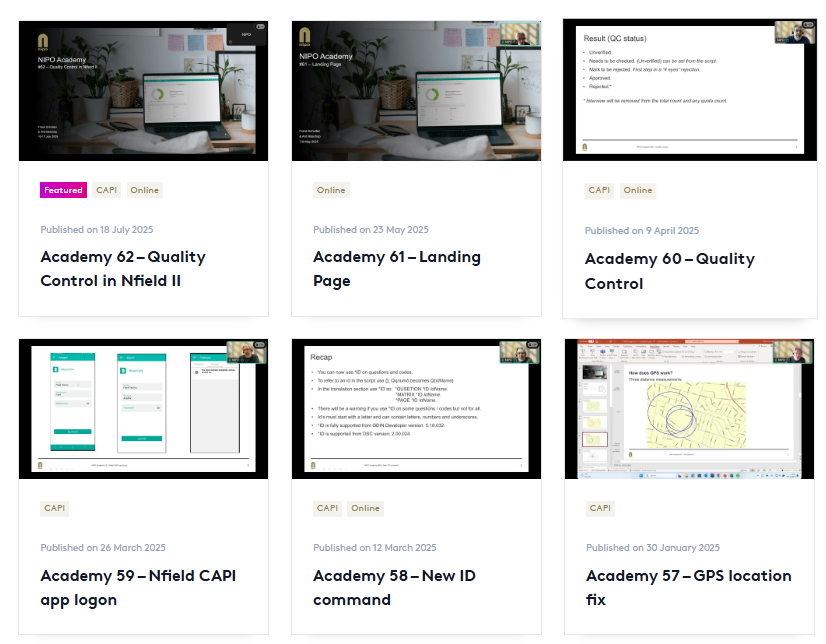
The Software and Documentation page on our website is NIPO’s centralized hub for supporting your technical setup and project management needs. Here, you can download software, view user documentation and access resources such as:
If you need to register your telephone number and contact information to gain access, please send your details to helpdesk@nipo.com.
Data security, compliance, and system reliability are all critical to everyone collecting insights in today’s global environment. For full transparency on how we protect your data, visit the Nfield Trust Center. Here, you’ll be able to find out about:
We encourage all IT and project management personnel to review this section as part of their onboarding.
Once you’re set up with the Nfield Manager, you can find courses, documentation and releases in the Knowledge Center area.

The NIPO blog is regularly updated with platform tutorials, case studies, best practices and news from around the world. It is a valuable source for staying up to date with Nfield enhancements and practical research insights.
To make sure you don’t miss our updates, we encourage you to subscribe to our LinkedIn page. Following us on LinkedIn will mean you get notifications when new articles about platform updates, and upcoming learning opportunities are published.
If you have any questions or encounter any technical issues during onboarding, our Support team is ready to assist. Reach out via our official support contact form.
For Kantar users, please contact us through your dedicated support portal for tailored assistance.
Our team can help you with setup, troubleshooting, access issues, survey publishing, and any other technical support you may require.
Nfield opens the door to robust, scalable, and secure data collection. By leveraging the training materials, support services, and community resources we provide, you’ll be well-equipped to design and execute high-quality research projects with confidence. We’re excited to welcome you to the community and look forward to supporting your success with Nfield.

ISO/IEC 27001 is the world’s best-known standard for managing information security. Satisfying its stringent specifications is essential for any organization that is entrusted with large amounts of user data, as we are here at NIPO.
Security and compliance have been core pillars of NIPO’s Nfield platform ever since it was launched in 2011. Having secured our first ISO 27001 certification back in 2013, we have continuously maintained it through rigorous annual audits.
Following intensive work upgrading our systems to conform with the latest ISO standards, we’re delighted to announce that NIPO has transitioned to ISO 27001:2022, with certification confirmed by SGS on 17 July 2025.
This is not just a milestone for NIPO; it directly benefits all Nfield users. We know this certification is increasingly vital for securing new projects, as clients rightly demand assurance that their data is safe and secure. With Nfield, that assurance is guaranteed.
The ISO/IEC 27001:2022 standard represents a substantial upgrade from the previous 2013 version. While the core framework remains intact, the 2022 revision introduces refinements that better align with today’s digital landscape and emerging threats.
Achieving this strategic information security management systems evolution required NIPO to undergo full recertification. A massive thank you goes out to the dedicated NIPO ISO Champions team for their fantastic work. Now, our business and our clients can truly benefit!
The certificate can be downloaded on the Compliance section of the Nfield Trust Center.
Validity of NIPO’s ISO certificate can be checked here:
https://www.sgs.com/en/certified-clients-and-products/verify-certificate?id=8d288c95-5220-4c5d-9947-bbe9655f78d9
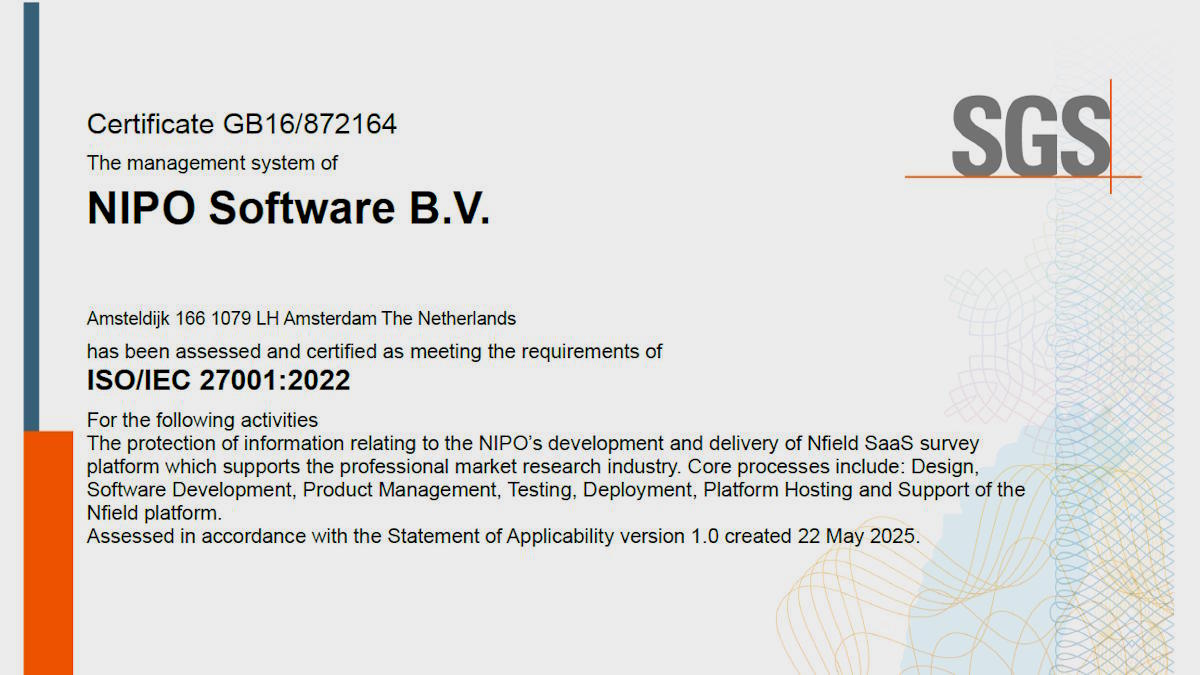
Keeping your Nfield domain clean, as in removing all outdated surveys and corresponding data, is essential for maintaining compliancy with data regulations. But that’s not the only reason to stay on top of things. Limiting what you store to what’s absolutely necessary is also better for both data security and efficient working. Here’s why.
Standards such as GDPR mean all kinds of businesses around the world need to ensure some form of data compliance. As these regulations typically include restrictions on how long you’re allowed to hold on to third-party data, having a regular clear-out is essential. This is especially the case for market research companies, whose business is all about third-party data!
The more data you have stored in your system, the more there is to steal. Which means any security breaches will have a bigger and further-reaching impact. Given the large amount of sensitive personal data that’s typically associated with market research, surveys are a highly prized target, as explained in our recent article about the value of Nfield logins on the Dark Web.
It therefore makes sense for your survey respondents and your business reputation to delete surveys, and all their corresponding data, as soon as you’re finished with them.
Good to know: Nfield upholds the highest security standards, adhering to the protocol established in ISO 27001:2022. Read more about Nfield security. However, users still need to take responsibility for protecting passwords, deploying 2-factor authentication and ensuring there are no unprotected “back doors” into their systems.
The less clutter there is within your system, the less likely it is that any of your team members will refer to the wrong information. Clearing out outdated surveys helps keep everybody on the same page, making it easier to work together on updating surveys and making decisions. A practice which can result in better teamwork, improved efficiency, and better outcomes for your business.
Nfield’s acceptable use policy includes domain limits on storage and the number of active surveys for each license level. Keeping your survey system clean can help you avoid exceeding your limits and incurring additional charges.
As solid as the reasons for keeping your system clean are, actually doing it can be a cumbersome task, especially when dealing with outdated or expired surveys. This is why Nfield introduced a new automatic survey clean-up feature which deletes inactive surveys that have reached their expiration date.
Further details about Nfield’s automatic clean-up feature can be found in our Nfield update published recently. Or see the NIPO Academy #39 session recording on this topic.

Market research is nothing without data. But unexpected events such as system failures, cyber-attacks or even natural disasters can result in data being compromised, lost or stolen. Having both robust security and a solid disaster recovery (DR) strategy are essential for protecting your data and maintaining its integrity.
Procedures related to Nfield’s internationally recognized ISO 27001:2022 certification for information security keep your data safe from unauthorized access. At the same time, Nfield’s highly disciplined approach to disaster recovery nothing is lost or damaged when the unexpected happens. In the event of prolonged downtime, whether caused by technical failure or external threat, your valuable data remains safe, secure, and readily accessible. So, you don’t need to worry about delayed project delivery, losing client trust, or missing opportunities.
Nfield’s disaster recovery approach is designed with both data protection and business continuity in mind.
Nfield operates exclusively on Microsoft Azure PaaS, which incorporates redundancy at every level: servers, networks, and databases. In the event of a server experiencing downtime, your data and operations automatically transfer to a different server in the same Azure data center. As a result, we are proud to report higher than 99.98% availability of our Nfield Interview Service.
Nfield users can always see what’s happening via a real-time status page, which shows availability of critical Nfield services across our four regional deployments in APAC, Europe and Africa, Americas and China.
Nfield fully enables automated backups of all project data, including survey responses and configurations. These backups are encrypted to the highest standards and stored in multiple secure locations in Azure, so that even in the event of a major system failure, your data can be recovered.
This backup process is aligned with industry best practices, providing you with peace of mind that your valuable data is always protected.
To further enhance data security, Nfield employs full, real-time geo-replication in Azure. To satisfy compliance requirements, this takes place within the same region as users’ primary Azure Data Centers. This means that, even in the event of the most extreme of disasters, such as an earthquake bringing down an entire Azure data center, no data is lost. And the latest data recovery technology enables operations to resume in as short a time as possible.
Nfield’s disaster recovery procedures are periodically tested, validated and safeguarded by our ISO procedures. A combination that ensures they will always work effectively, as and when needed. The routine tests allow our team to identify and fix any potential vulnerabilities, so both they and the platform are always ready to recover from any outages.
Nfield’s disaster recovery strategy follows ISO 27001:2022 guidelines. This is, however, just one aspect of a larger and more comprehensive approach towards security. The Nfield platform’s focus on protecting data from breaches, loss, and unauthorized access is central to its design, reflecting an ethos that runs through the NIPO team’s DNA. Your data remains completely safe during both normal operations and disaster recovery. Learn more about Nfield data security.
Disaster recovery is a critical consideration for any SaaS platform provider, and a top-priority when data collection and market research are your business. We understand the questions your teams will be asked by their customers, procurement teams and security officers, and are happy to provide all the information you need to respond.
Also worth knowing, is that Nfield’s comprehensive disaster recovery framework is continuously evolving and improving as it benefits from Microsoft’s own massive investments in Azure and its software development suites. For full information on Microsoft Azure security and compliance, please refer to the Microsoft Azure Trust Center.
In short, Nfield is designed to prevent any disruption to your (market research) work, thereby ensuring your business continuity and operational resilience. NIPO’s commitment to Nfield’s security, compliance and reliability means you and your customers can rest assured that data is maximally safe, and projects will be delivered on-time. No matter what disrupting challenges may arise.

Keeping your valuable data safe is an absolute priority for us. It’s an obligation that guides everything we do when shaping and powering Nfield’s features. Every conceivable measure is taken to ensure both our team and our software solutions comply with the highest security standards.
Keeping your data secure depends on a wide range of measures working harmoniously together. A good way to visualize this is to imagine Nfield as a physical office building, where all the different market research and security departments are based. As with all commercial buildings, it is itself protected and complemented with off-site operations.
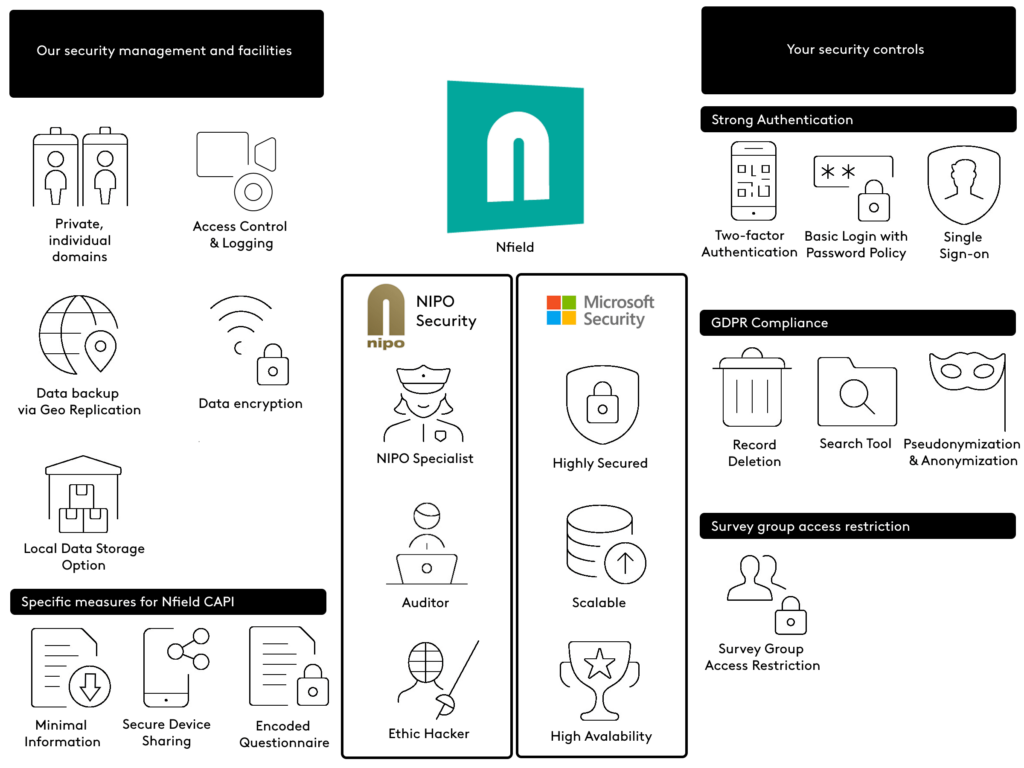
(click image to enlarge)
Our Information Security Management System is ISO 27001:2022 certified. The same as followed by our platform provider, Microsoft.
We maintain a strong security policy that ensures both your data, and our products are safeguarded round the clock. Independent security experts (ethical hackers) scrutinize our security procedures every year to evaluate our tools, processes and people. The measures to conform with ISO 27001:2022 for our Information Security Management System, as certified by an auditor (Auditor), are strictly followed in every wire connection and by every person in our company. As a matter of principle, the smallest possible number of NIPO specialists have access to Nfield’s infrastructure for carrying out deployments and maintenance. See the Nfield Trust Center where you’ll find information about NIPO practices related to security, compliance, and privacy, in the form of documents that can be shared with your clients.
Nfield runs on Microsoft Azure, the highly secured cloud known for its flawless, trusted performance, extensive data storage and reliability. Microsoft’s engineers work 24/7 to protect the cloud, scale its powers and administer other services which run on it, including Office365. For more information, please visit the Microsoft Trust Center for up-to-date details on policies, processes, and practices that help you manage data control and comply with industry and government regulations.
Nfield provides a number of different features that enable you to secure your domain to the highest level.
Two-factor Authentication (2FA): Nfield accounts secured with two-factor authentication require users to enter a code (a token) generated by a standard authenticator app on a mobile phone. This has the effect of complementing something you know (your username and password) with a code obtained through something you have (your phone). It effectively blocks any unauthorized access to your Nfield account, even from those who have obtained your username and password, as these people (or their machines) are unable to retrieve the second factor code from the phone. Your valuable Nfield fieldwork and respondent data is thereby protected from prying eyes. Learn more in our article Protecting your Nfield login with two-factor authentication.
Single-Sign-On (SSO): For enterprises, Nfield can be set up to use Office 365 accounts for Nfield login. Administration of your Nfield user accounts, for as many Nfield domains as you have, is centralized in your organization’s single-sign-on layer. In the case of an employee leaving the organization or other reason for revoking a person’s system access (e.g. because of a security breach), Nfield will automatically be included in the revoked permissions, with immediate effect from when the account in the single-sign-on layer is disabled or reset. With SSO, your password policy for accessing Nfield is automatically aligned with that of your organization.
Strong password policy: Nfield can easily be configured to comply with strong password policies. Domain administrators can set rules for things such as password expiration period, old password re-use and strong password requirements (e.g. minimum number of characters and different character sets). You should also regularly revalidate your authorized users and ensure immediate removal of departing employees.
Surveys contain valuable, and sometimes sensitive, information. It’s therefore essential to restrict access to certain parts of surveys to those who really need it to do their jobs. This is done by assigning users with specific roles which only allow access to designated areas and functionality. Find out more in our article Controlling access to survey rights. Setting the right access also limits the scope of risk in the case of data breach.
The hypothetical building we’ve used to illustrate Nfield’s operation is managed by NIPO, who take care of its security and facilities to ensure compliance with the highest security and privacy standards. Our Information Security Management System is ISO 27001:2022 certified. We have procedures for everything, encrypt your data everywhere, limit access across the board and continuously test for potential security flaws.
Your projects are stored in your own individual domain, inaccessible to anyone else – even our employees – unless explicitly requested by you for customer support purposes.
Nfield allows administrators to configure access on a user-by-user basis, defining the scope of activities every user is allowed to perform. Password requirements can also be set to enforce your chosen password policy, however strong you need it to be. All user actions are tracked and domain administrators can review them individually. The system automatically signs users out when inactive for more than 15 minutes.
Your collected data is stored in secure Microsoft SQL database servers and replicated in other data centers so it can be restored in the event of something going wrong. Microsoft security policies strictly regulate access to its data centers.
All your data is secured by SSL and encrypted, both at rest and during transfer, to protect it from sniffing.
Different countries and industries often have their own specific regulations when it comes to data storage. To comply with this, market research companies need to give careful consideration to where their respondent data is stored. To enable data storage compliance, we have developed the ability to separate survey deployment from storage of respondent data. This means it is now possible, for example, to deploy a survey from the Hong Kong SAR Microsoft Data Center and store the respondent data in the Singapore Microsoft Data Center. Find out more in our article Local Data Storage Compliance, around the World.
Tablet devices are desirable prizes for thieves. Their thin, lightweight nature also makes them easy to forget about and accidentally leave behind. Nfield therefore also deploys additional measures to limit the extent of data exposure risk due to being locally stored on a mobile device.
Nfield ensures the minimum amount of information possible is present on any mobile device at any given moment. Each device is only sent the surveys and associated respondent information specifically assigned to its user(s). Data that no longer needs to be accessible is removed as soon as possible.
The same mobile device can be shared by multiple interviewers. Each survey and its collected data is only accessible to the relevant interviewer, via their login credentials. Interviewers cannot review, start or modify any surveys not specifically assigned to them.
Nfield questionnaires are stored in an encoded proprietary format. The original script is never displayed in an interviewer’s device, so interviewers cannot make changes.
Fully compliant practices, means you can rest assured when it comes to data security. And with cloud-based operation delivering unbeatable cost-efficiency together with all the capacity you need, whenever you need it, Nfield is the ultimate solution for improving both your quality of work and your profit margins.

Trust is critical in market research, especially with regards to raw data. Your respondents trust you with all kinds of sensitive data about their lives, you need to be able to trust us to keep that data safe. That is why NIPO is committed to offering the most secure survey solutions for the professional market research industry. Our ISO 27001:2022 certification is strong and independent proof in how we are leading the area of data security.
Nfield includes features to assist you in your efforts to address GDPR controls. Such features include the ability to search cross surveys for respondents, to delete or pseudomize interviews and to anonymize data in surveys.
Our goal is simple: To provide functionality in nfield so our customers can address GDPR controls without having them compromise on data collection efficiency.
For this we created a booklet, we call it our Nfield GDPR toolkit, that highlights the Nfield features that can help you to address GDPR. A guide like this can never be 100% complete, so please feel free to reach out to your sales representative with any questions you might have around Nfield and its functionality.
Download your copy of the toolkit now:
https://support.nipo.com/Nfield/Nfield-GDPR-Toolkit_v2_18July2025.pdf
Please note that this toolkit is not a replacement for legal advice. We recommend that, in case you have not done so yet, you seek legal advice on how GDPR applies specifically to your organization, and how best to ensure compliance.
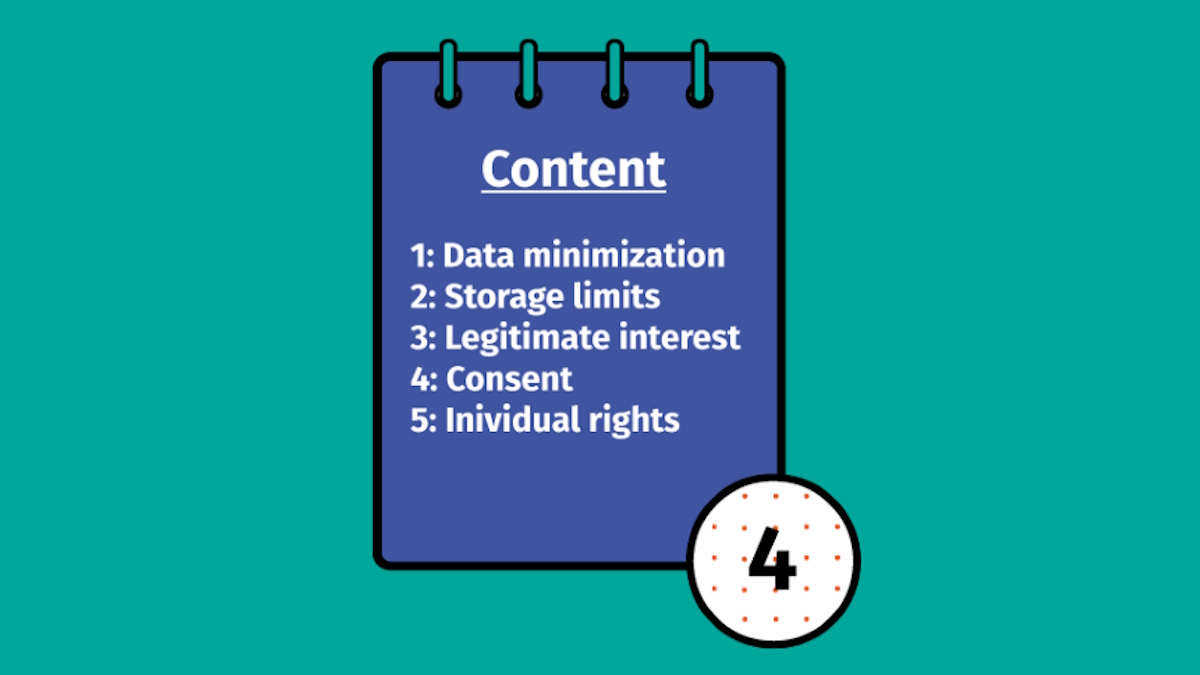
In the NIPO Academy 60 sessions we introduced new Quality Control features that were in preview mode at the time. Since then, we have added new options and have released all functionality to every user. In this session we cover all facets of Quality Control in Nfield, relevant to both Online and CAPI projects.
These Online features include:
After that, we end section specific to CAPI. Topics included here:
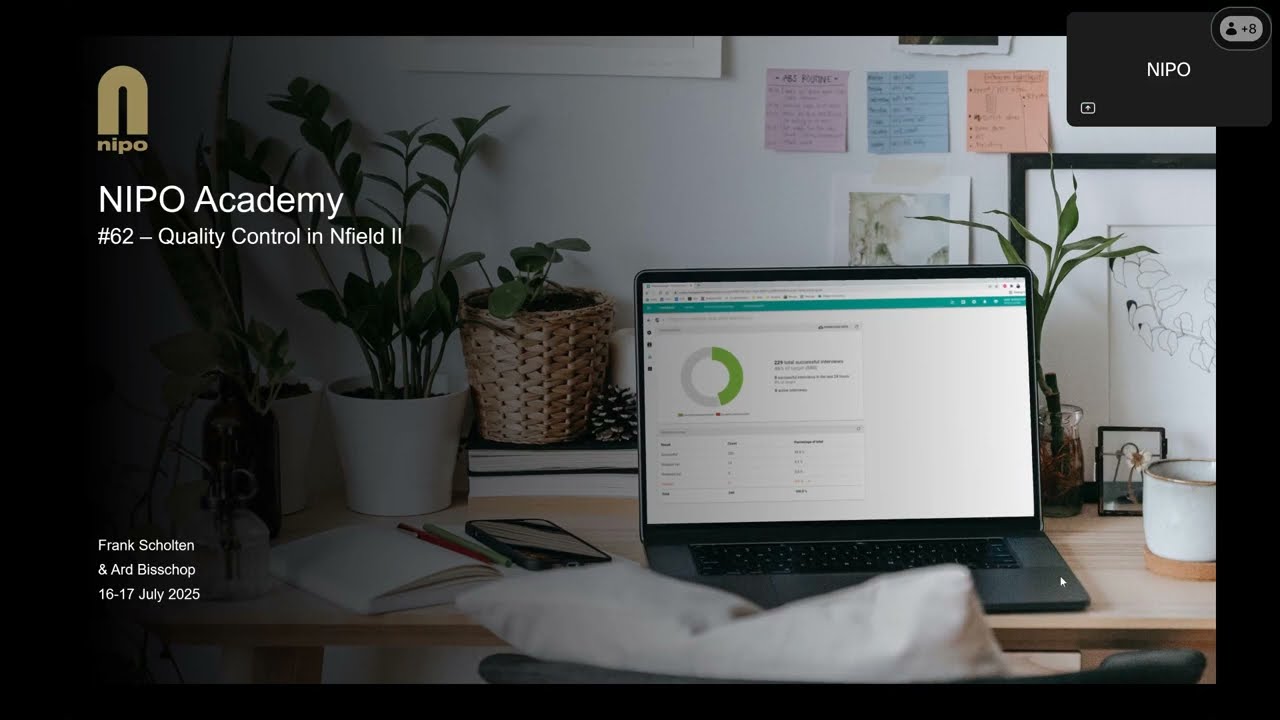

Request a demo to see how NIPO can help you meet your requirements with our smart survey solutions.